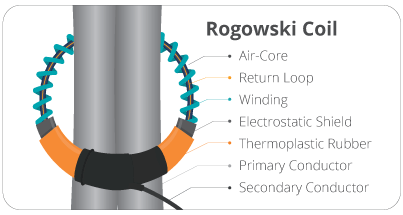What is a Rogowski Coil?
Named after German physicist Walter Rogowski, a Rogowski coil is a flexible current transformer that is used to measure alternating current (AC) in a variety of power monitoring applications. Like other types of current transformers, a Rogowski coil is typically installed in an electrical panel or switchgear and then connected directly, or indirectly via an integrator, to an energy or power meter to obtain accurate amperage measurements.

Although they are both designed for taking electrical measurements, there are notable differences in the construction of a traditional current transformer, such as a split-core or solid-core sensor, and a Rogowski coil. The core of a typical current transformer is constructed from rigid metal, such as iron alloy or a type of steel. In contrast, a Rogowski coil does not have a metal core and features a toroidal winding of copper wire precisely wrapped around a flexible, non-magnetic air core, which is a tube consisting of a plastic or rubber material. As the copper wire is wrapped around to the end of the core, the terminus of the winding passes back through the center of the hollow air core, returning to the same position as the other end of the copper wire. This design allows the Rogowski coil to be opened and closed for convenient installation over live conductors with minimal disruption and can bend to accommodate tight installation spaces.
Another difference between Rogowski coil sensors and traditional current transformers is the output signal. Common outputs for split-core or solid-core sensors typically include 333mV, 5A, or 1A. Current transformers with these outputs can generally be directly connected to power meters or other industrial equipment without the need for intermediary hardware solutions. On the other hand, a Rogowski coil’s output is a low voltage AC signal that can range from approximately 2mV to 500mV per 1000 amps. While Accuenergy meters are directly compatible with Rogowski coil sensors, many meters cannot work directly with their low voltage output and require the use of an amplifier/integrator to boost the output to a usable signal, such as 333mV or 5A. It is important to check the specifications of your device when deciding on what type of current transformer to use.
What are Three Advantages of a Rogowski Coil Current Transformer?
No Saturation at High Currents
Current transformers with a metal core reach a saturation point when the primary current is high enough that the sensor can no longer provide a secondary current that is proportionally accurate to the primary current. This can happen when a CT is used on a service outside its specified range and, besides potentially causing damage to the CT, it will also provide inaccurate amperage readings. Not only do Rogowski coil sensors accurately operate on high amperage loads with ease, but their air core never saturates.
Lightweight and Flexible
One reason a Rogowski coil may be selected over a rigid-body current transformer is their lightweight, flexible design. Not only does this make them easy to install in tight electrical panels or around large conductors, but it can significantly reduce the installation time, saving money.
Superior Frequency Response
When compared to traditional CTs, a Rogowski coil’s low inductance means they have a high frequency response and can adapt to rapidly changing electrical loads within a fraction of a second. Overall, they offer superior performance in power monitoring applications with high, fast-changing current.
 X
X 
 X
X  X
X  X
X